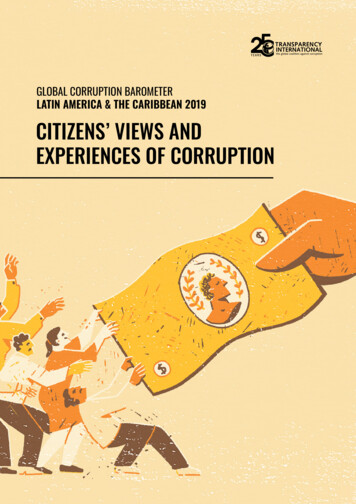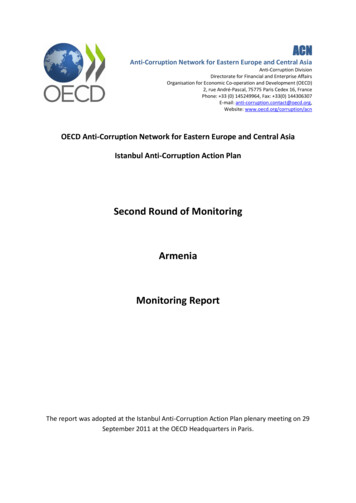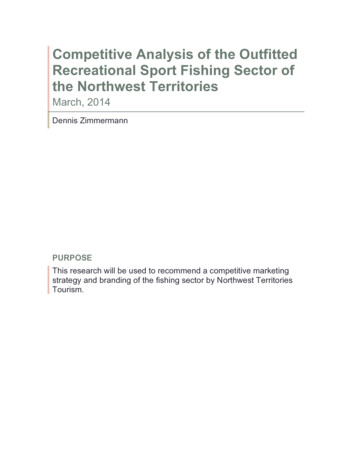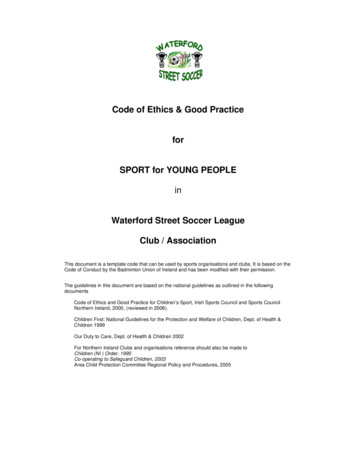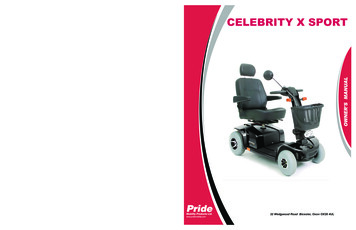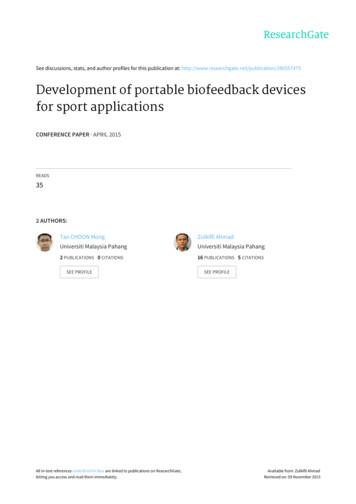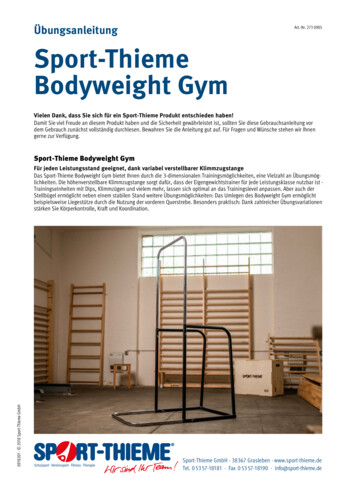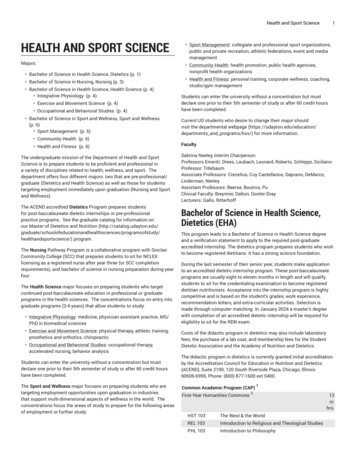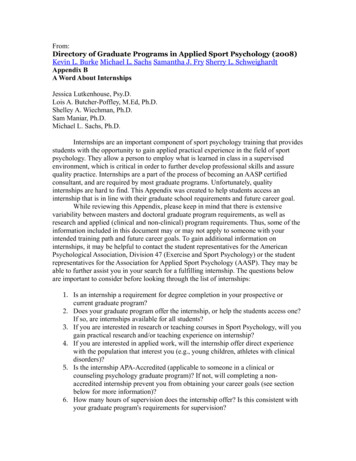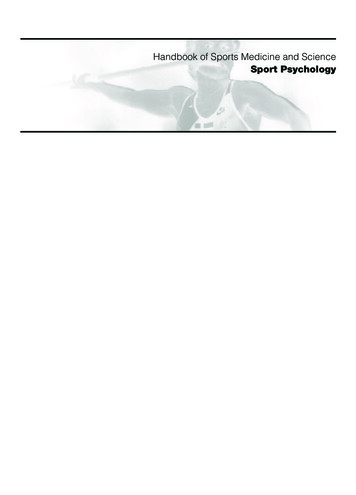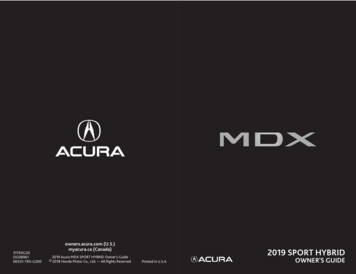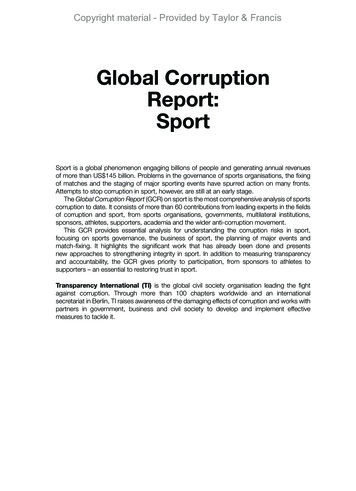
Transcription
Copyright material - Provided by Taylor & FrancisGlobal CorruptionReport:SportSport is a global phenomenon engaging billions of people and generating annual revenuesof more than US 145 billion. Problems in the governance of sports organisations, the fixingof matches and the staging of major sporting events have spurred action on many fronts.Attempts to stop corruption in sport, however, are still at an early stage.The Global Corruption Report (GCR) on sport is the most comprehensive analysis of sportscorruption to date. It consists of more than 60 contributions from leading experts in the fieldsof corruption and sport, from sports organisations, governments, multilateral institutions,sponsors, athletes, supporters, academia and the wider anti-corruption movement.This GCR provides essential analysis for understanding the corruption risks in sport,focusing on sports governance, the business of sport, the planning of major events andmatch-fixing. It highlights the significant work that has already been done and presentsnew approaches to strengthening integrity in sport. In addition to measuring transparencyand accountability, the GCR gives priority to participation, from sponsors to athletes tosupporters – an essential to restoring trust in sport.Transparency International (TI) is the global civil society organisation leading the fightagainst corruption. Through more than 100 chapters worldwide and an internationalsecretariat in Berlin, TI raises awareness of the damaging effects of corruption and works withpartners in government, business and civil society to develop and implement effectivemeasures to tackle it.
Copyright material - Provided by Taylor & Francis“Transparency International have for years undertaken valuable, authoritative workon governance issues of vital importance in sport, and the concerns they haveraised have been repeatedly vindicated. The research and insights in this bookprovide another major contribution to the recognition that sports must be true to thelove people have for them.”–David Conn, The Guardian“At last a truly comprehensive, critical and impassioned look at the whole range ofgovernance and corruption issues that have engulfed global sport. For those thatwant to know what has been going on, why, and how to do something about it, thisbook will be their first point of call.”–David Goldblatt, award-winning author of The Game of Our Lives:The Meaning and Making of English Football
Copyright material - Provided by Taylor & FrancisGlobal CorruptionReport:SportTransparencyInternational
Copyright material - Provided by Taylor & FrancisFirst published 2016by Routledge2 Park Square, Milton Park, Abingdon, Oxon OX14 4RNand by Routledge711 Third Avenue, New York, NY 10017Routledge is an imprint of the Taylor & Francis Group, an informa business 2016 Transparency InternationalEditor: Gareth Sweeney, Associate Editor: Kelly McCarthyThe right of Transparency International to be identified as the author of theeditorial material, and of the authors for their individual chapters, has beenasserted in accordance with sections 77 and 78 of the Copyright, Designsand Patents Act 1988.All rights reserved. No part of this book may be reprinted or reproduced orutilised in any form or by any electronic, mechanical, or other means, nowknown or hereafter invented, including photocopying and recording, or in anyinformation storage or retrieval system, without permission in writing from thepublishers.Trademark notice: Product or corporate names may be trademarks orregistered trademarks, and are used only for identification and explanationwithout intent to infringe.British Library Cataloguing-in-Publication DataA catalogue record for this book is available from the British LibraryLibrary of Congress Cataloging-in-Publication DataA catalog record for this book has been requestedISBN: 978-1-138-90589-4 (hbk)ISBN: 978-1-138-90592-4 (pbk)ISBN: 978-1-315-69570-9 (ebk)Typeset in Helveticaby Keystroke, Station Road, Codsall, Wolverhampton
Copyright material - Provided by Taylor & FrancisContentsList of illustrations xiPreface Cobus de Swardt, Managing Director, Transparency InternationalxiiiForeword Raí Souza Vieira de Oliveira, founder of the Gol de Letra Foundation andcaptain of the Brazilian 1994 World Cup winning teamxvAcknowledgements xviiExecutive summary Gareth Sweeney, Editor, Global Corruption Report, Transparency InternationalxixPart 1 Governance of sport: the global view 11.1Sport as a force for good Bob Munro, Mathare Youth Sports Association and Mathare United FC31.2Fair play: ideals and realities Richard H. McLaren, McLaren Global Sport Solutions1.3Autonomy and governance: necessary bedfellows in the fightagainst corruption in sport Jean-Loup Chappelet, IDHEAP Swiss Graduate Schoolof Public Administration1.4Obstacles to accountability in international sports governance Roger Pielke Jr, University of Colorado1.5Political interference, power struggles, corruption and greed:the undermining of football governance in Asia James M. Dorsey, S. Rajaratnam School of International Studies121629391.6Corruption in African sport: a summary Chris Tsuma, Africa Centre for Open Governance (AfriCOG)441.7Impunity and corruption in South American football governance Juca Kfouri, Folha de São Paulo52
Copyright material - Provided by Taylor & FrancisviContents1.8Indicators and benchmarking tools for sports governance Arnout Geeraert, Catholic University of Leuven561.9Examples of evolving good governance practices in sport Michael Pedersen, M INC621.10 For the good of the game? Governance on the outskirtsof international football Steve Menary, World Soccer651.11 Image-laundering by countries through sports Naomi Westland, Amnesty International UK731.12 Opening the door to corruption in Hungary’s sport financing Miklós Ligeti and Gyula Mucsi, Transparency International Hungary791.13 Challenges and approaches to ensuring good governance ingrassroots sport Mogens Kirkeby, International Sport and Culture Association (ISCA)1.14 The Code of Ethics for sport in the Municipality of Milan:a grassroots approach against organised crime and corruption in sports Paolo Bertaccini Bonoli, Transparency International Italy,and Caterina Gozzoli, Catholic University of MilanPart 2 Money, markets and private interests in football 8894992.1Offside: FIFA, marketing companies and undue influence in football Jamil Chade, O Estadão1012.2Measuring the United Kingdom’s ‘offshore game’ George Turner, Tax Justice Network1052.3Unfit, improper ownership in UK football clubs Arjun Medhi, UK Chartered Institute for Public Finance and Accountancy1092.4Agents and beyond: corruption risks in the football transfer marketand the need for reform Raffaele Poli, Football Observatory of the Centre Internationald’Étude du Sport, University of Neuchâtel1142.5Third-party ownership of football players: human beings or traded assets? Jonas Baer-Hoffmann, FIFPro1182.6Origins, practice and regulation of third-party ownership in South America Alexandra Gómez Bruinewoud, FIFPro, and Gonzalo Bossart,Alessandri, Bossart, Pacheco and Cia125
Copyright material - Provided by Taylor & FrancisContentsviiPart 3 Events in the spotlight 1313.1The multiple roles of mega-events: mega-promises, mini-outcomes? Martin Müller, University of Zurich1333.2Who bids for events and why? Scarlett Cornelissen, Stellenbosch University1393.3The problem with sporting mega-event impact assessment Eleni Theodoraki, Edinburgh Napier University1433.4Corruption and the bidding process for the Olympics and World Cup Andrew Zimbalist, Smith College1523.5Compromise or compromised? The bidding process for the awardof the Olympic Games and the FIFA World Cup Stefan Szymanski, Michigan Center for Sport Management157The planning and hosting of sports mega-events: sources,forms and the prevention of corruption John Horne, University of Central Lancashire163Preventing corruption in the planning of major sporting events:open issues Wolfgang Maennig, Hamburg University169Malpractice in the 2010 Delhi Commonwealth Games andthe renovation of Shivaji Stadium Ashutosh Kumar Mishra, Transparency International India174Preventing corruption ahead of major sports events: learning fromthe 2012 London Games Kevin Carpenter, Captivate Legal and Sport Solutions1783.63.73.83.93.10 The 2014 Sochi Winter Olympics: who stands to gain? Oleg Golubchikov, Cardiff University1833.11 The need for transparency and monitoring aheadof the 2018 World Cup in Russia Anna Koval and Andrew Jvirblis, Transparency International Russia1923.12 Sporting mega-events, corruption and rights: the caseof the 2022 Qatar World Cup Sharan Burrow, International Trade Union Confederation1983.13 The Brazilian experience as ‘role model’ Christopher Gaffney, University of Zurich204
Copyright material - Provided by Taylor & FrancisviiiContents3.14 Rio 2016 and the birth of Brazilian transparency Andy Spalding, Pat Barr, Albert Flores, Kat Gavin, Shaun Freiman,Tyler Klink, Carter Nichols, Ann Reid and Rina Van Orden,University of Richmond2113.15 Sports mega-event legacies: from the beneficial to the destructive Helen Lenskyj, University of Toronto2183.16 Urban speculation by Spanish football clubs Nefer Ruiz Crespo, Transparency International Spain223Part 4 Match-fixing 2294.1Why sport is losing the war to match-fixers Declan Hill, investigative journalist2314.2The role of the betting industry Ben Van Rompuy, TMC Asser Institute2364.3Cricket in Bangladesh: challenges of governance and match-fixing Iftekhar Zaman, Rumana Sharmin and Mohammad Nure Alam,Transparency International Bangladesh2424.4The gap between sports institutions and the public will: responsesto match-fixing in Lithuania Rugile Trumpyte, Transparency International Lithuania2504.5Australia’s ‘National Policy on Match-Fixing in Sport’ Jane Ellis, Transparency International Australia2544.6Match-fixing: the role of prevention Ulrike Spitz, Transparency International Germany2574.7New media approaches to tackling match-fixing in Finnish football Annukka Timonen, Transparency International Finland2624.8Prevention and education in match-fixing: the European experience Deborah Unger, Transparency International2644.9The Austrian approach: how to combat match-fixing and promoteintegrity in sport Severin Moritzer, Play Fair Code269Part 5 The US model: collegiate sports and corruption 2735.1275The roots of corruption in US collegiate sport Donna Lopiano, Sports Management Resources
Copyright material - Provided by Taylor & FrancisContents5.2Academic fraud and commercialised collegiate athletics: lessonsfrom the North Carolina case Jay M. Smith, University of North Carolina, Chapel Hillix2865.3The evolution of professional college sport in the United States Allen Sack, University of New Haven2935.4Inequality, discrimination and sexual violence in US collegiate sports Erin Buzuvis, Western New England University, and Kristine Newhall,University of Massachusetts, Amherst300Part 6 The role of participants: within and beyond the sports family 6.1The International Olympic Committee’s actions to protect theintegrity of sport Pâquerette Girard Zappelli, International Olympic Committee3073096.2Combating the risk of corruption in sport: an intergovernmentalperspective 313Stanislas Frossard, Council of Europe, Enlarged Partial Agreement on Sport6.3UNESCO: building on global consensus to fight corruption in sport Nada Al-Nashif, UNESCO6.4The role of Switzerland as host: moves to hold sports organisationsmore accountable, and wider implications Lucien W. Valloni and Eric P. Neuenschwander, Froriep6.5Promoting integrity in sport: a sponsor’s perspective Jaimie Fuller, SKINS6.6A player’s perspective on the need for reform to enhancetransparency and integrity in sports Louis Saha, Axis Stars3183213273326.7Organised athletes: a critical voice in sports governance Brendan Schwab, UNI World Athletes3356.8The role of supporters in effective governance Ben Shave and Antonia Hagemann, Supporters Direct3396.9Learning from others: the Kick It Out campaign Richard Bates, Kick It Out3456.10 Big business blurs sports journalism’s critical eye Peter English, University of the Sunshine Coast347
Copyright material - Provided by Taylor & FrancisxContents6.11 New ball game: covering sports, with teams as competitors John Affleck, John Curley Center for Sports Journalism3526.12 What the anti-corruption movement can bring to sport: the experienceof Transparency International Germany Sylvia Schenk, Transparency International Germany359Index 363
Copyright material - Provided by Taylor & FrancisIllustrationsFigures1.11.21.31.42.1Key decisions in the evolution of ‘sports autonomy’ The need for governance Subsidised football clubs in Hungary, 2011–2015 The church model of sport Percentage of individual agents or agencies (entities) with clients inthe ‘Big Five’ leagues according to the percentage of players represented 3.1 Sports-related cost overruns, 1998–2012 Olympics 3.2 Domestic inputs to major event bids 3.3 Event stakeholder power–risk irony 3.4 Concepts and levels of focus 3.5 Sporting mega-event impact sphere 3.6 South Africa 2010 3.7 Costs of the Olympic Games per capita and as a percentageof GDP, 2002–2014 3.8 The geography and funding of mega-events in Russia 3.9 Estádio Nacional de Brasília Mané Garrincha: Brasilia’s white elephant 3.10 Land value before and after construction of the New Condominastadium, Murcia 4.1 Match-fixing: football versus basketball 4.2 All bets are off 5.1 Highest paid public employee collegiate sports head coach 5.2 ‘Potemkin’ courses for athletes 6.1 Support versus influence 287341Tables1.13.13.23.3Vote weighting in the Badminton World Federation Scoring matrix for event classes according to size Size classification of selected events Public funds budgeted for the 2018 World Cup preparations 63–64133134193Boxes1.11.21.31.41.51.6Th
Tyler Klink, Carter Nichols, Ann Reid and Rina Van Orden, University of Richmond 3.15 Sports mega-event legacies: from the beneficial to the destructive 218 Helen Lenskyj, University of Toronto 3.16 Urban speculation by Spanish football clubs 223 Nefer Ruiz Crespo, Transparency International Spain part 4 Match-fixing 229
